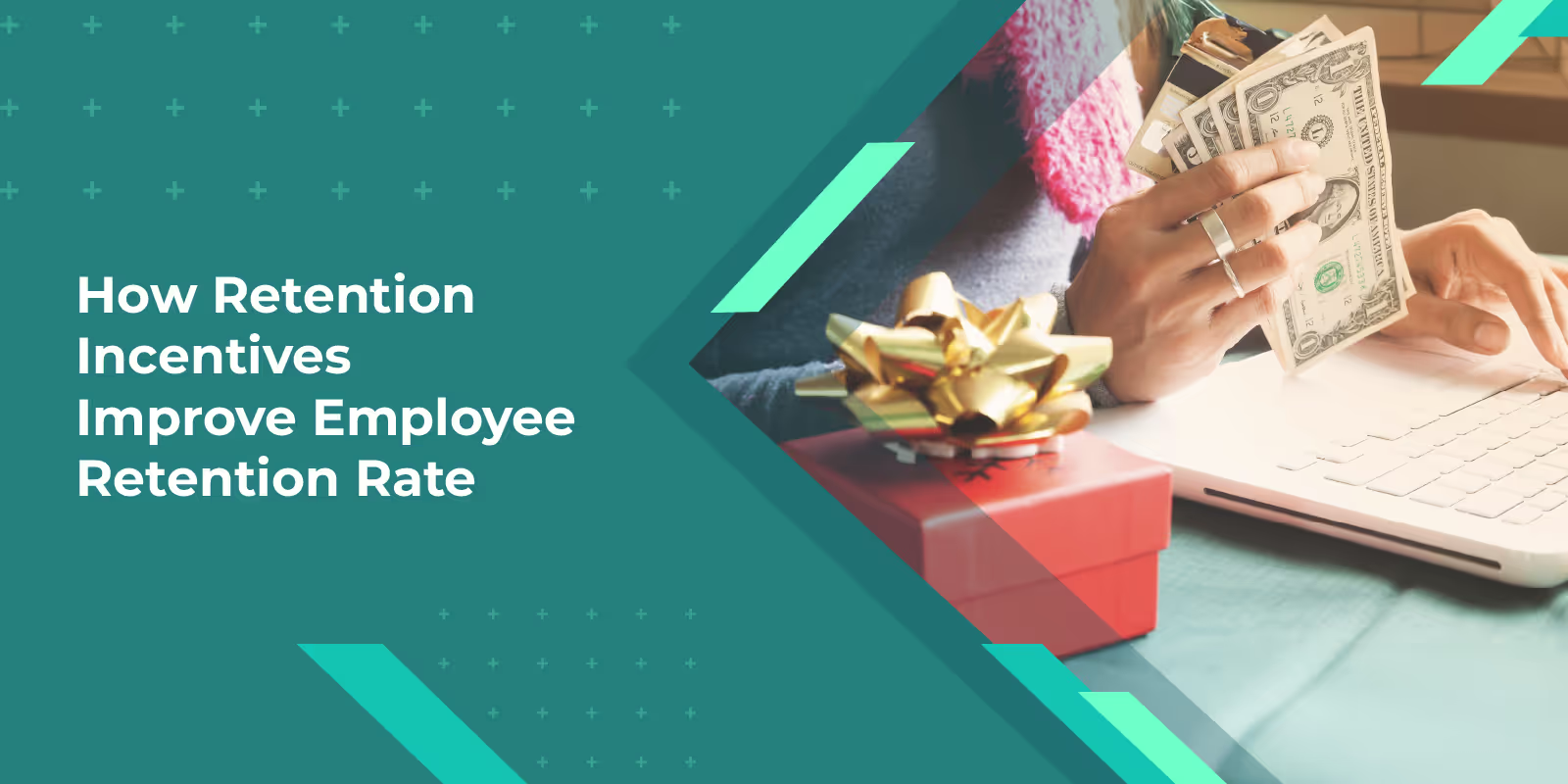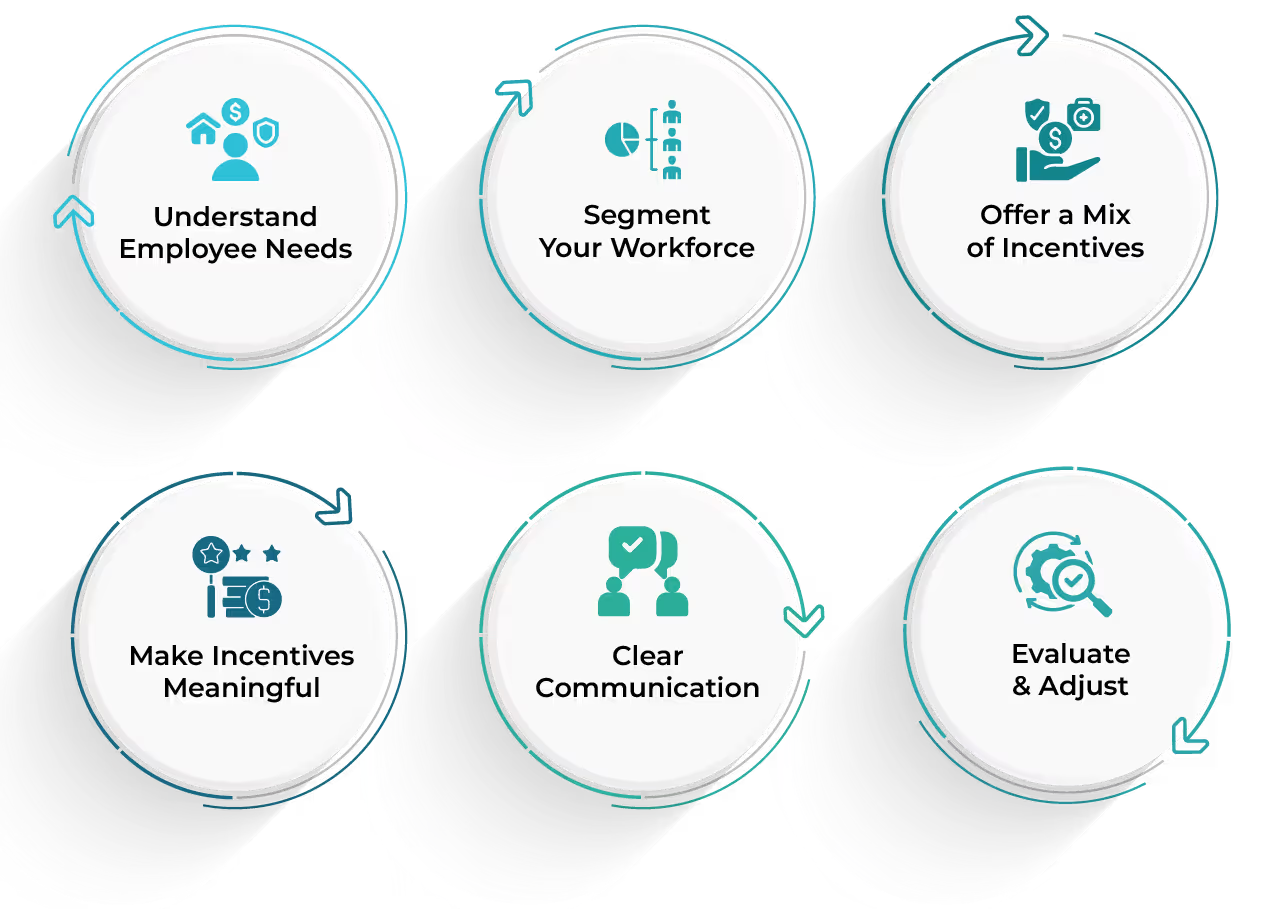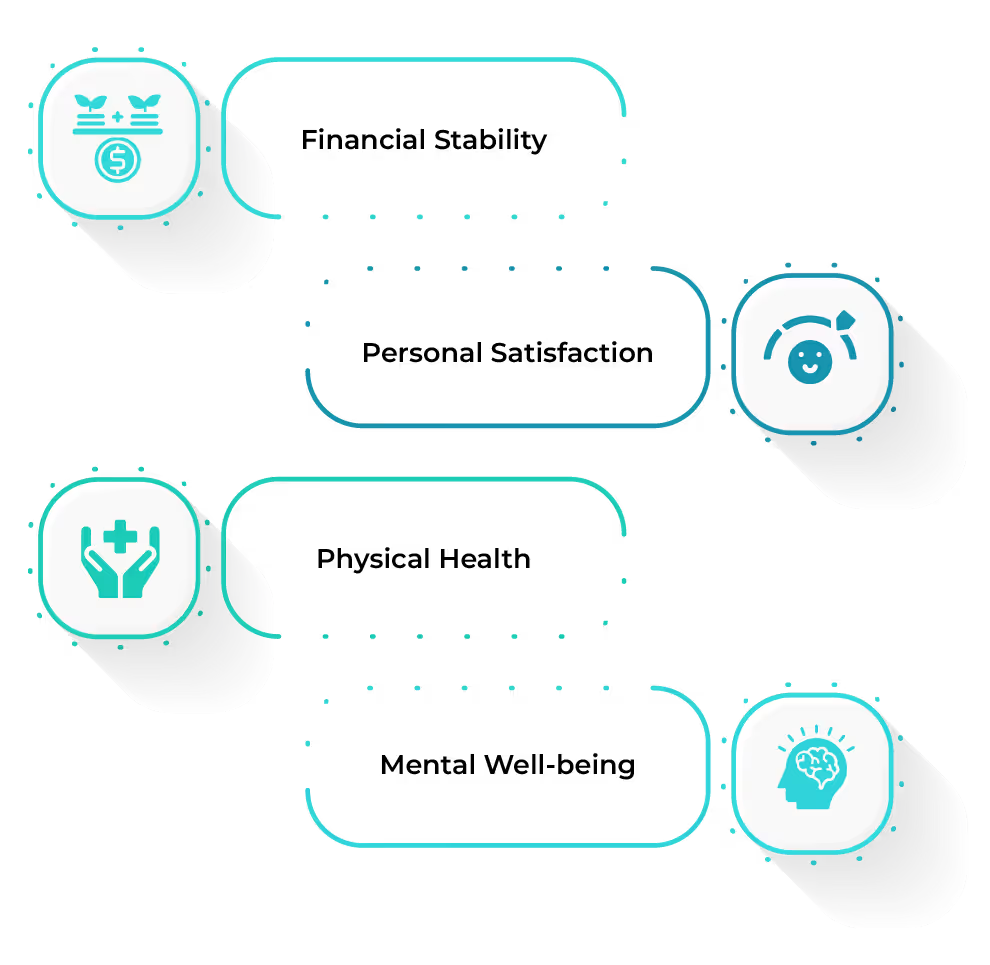
Blog
How Retention Incentives Improve Employee Retention Rate
May 20, 2024


Key Insights
Dear HR, you are doing everything in your power to improve the work culture.
You are ensuring flexible work hours, and building a healthy work culture, but something seems to miss the target. Despite all these efforts, the turnover rate remains high.
It's time to address the elephant in the room - As a part of building your company culture, have you implemented a system for recognizing your employee efforts?
It is a fact that employees want and need acknowledgment for the work they do. It can be a reward for achieving milestones or constructive feedback for improvement.
If you leave the employee without feedback, it makes them feel stagnant and unmotivated and eventually leave the company in silence.
Surely, with all the efforts you've invested, that's not the outcome you want.
So here is the solution: retention incentives.
In this article, we walk you through understanding employee retention bonus programs. We deal with some targeted strategies, benefits, and steps to crafting a retention program.
We will share some of the do’s and don’ts of retention incentives, some alternative incentives to retain employees, and innovative approaches to enhance your retention program.
What are Retention Incentives?
HRs are well aware that employees change jobs every two to three years. This makes retaining skilled professionals a hard task.
In such a scenario, retention incentives can come to your aid. It rewards your employees with financial and non-financial benefits and encourages them to stay with the company.
It is usually used by employers in industries where there is high turnover or where there is a demand for skilled talents.
Incentives to retain employees will further reduce your recruitment and training costs. It will also help create a stable and productive workforce without disrupting operations.
What are some of the Targeted Retention Incentive Strategies
Employee retention bonus programs fulfill a niche purpose. Its primary aim is to keep employees satisfied and to reduce their turnover.
With the help of some strategies, you can further enhance this purpose. Here are a few niche strategies that help optimize your retention incentive program:
- Identify the key employees of your organization. The ones with skilled and specialized knowledge. Provide them the opportunity for upskilling, career development, and mentorship.
- Provide flexible work arrangements like remote working, flexible hours, etc. This helps employees improve their work-life balance and enhance job satisfaction.
- Recognize your employee achievements. Public appreciation and performance awards can impact their morale and commitment.
- Talk to your employees. Gather their feedback to understand their concerns, needs, and preferences.
- Provide growth opportunities through promotions and leadership development. This creates a sense of ownership, belongingness, and purpose within the organization.
HRs, retaining an employee is easy if you know the right tips and tricks. The above tips show how important it is to make your employees feel seen and appreciated.
You must recognize your employees through verbal appreciation or monetary rewards. This can positively impact their overall attitude and performance.
What are the Benefits of Retention Incentives?
Retention incentives are a win-win situation for both the employer and the employee.

For Employer
From an employer's perspective, the cost of retaining an employee is much lower than hiring a new one. But the benefit of retention incentives goes beyond financial gains.
It can have a larger impact on the work culture and the overall operations.
For example, when an employee leaves it disrupts the workflow and the team dynamics. Retention incentives maintain continuity of work by ensuring employee satisfaction.
Companies put a lot of effort into training their employees. Over the years they gain new knowledge and skills. When such skilled professionals leave, it is a huge loss for the company.
Implementing employee retention bonus examples encourages employees to stay. This helps companies preserve their institutional knowledge.
Retention incentives make employees feel valued and appreciated. This can positively impact their confidence, performance, and productivity.
These efforts enhance both employee satisfaction and company culture.
For Employee
Even from an employee perspective, the perks of employee retention bonuses are endless.
For the primary reason, it gives them financial stability. Incentives in the form of bonuses, increments, and stocks serve as positive reinforcement.
Companies with employee retention bonuses create a sense of job security in employees. This reduces their anxiety about job stability and enhances their productivity.
Retention incentives can also be in the form of career development opportunities. This includes training programs, workshops, and skill development opportunities.
This shows the company's investment in the long-term success of its employees.
Companies that offer flexible work arrangements help employees enjoy a work-life balance. This motivates employees to enhance performance without compromising their personal life.
Retention bonus programs are a prime example that only when employees feel truly valued can the company improve its performance.
But this also calls for building an effective retention program that caters to your needs. Here is a systematic approach to go about crafting your retention incentive program.
Crafting Effective Retention Incentive Packages
Building an effective retention incentive needs time and effort. You need to put in the thought to include factors that cater to the organization and employee needs.
Confused about what these factors are and how to go about it? We have the perfect guide for you.
Let's take a step-by-step approach to crafting your effective retention incentive program:

Understand Employee Needs
Companies must ask their employees about their needs, preferences, and requirements. This helps tailor incentive types that will bring the best out of your employees.
Segment Your Workforce
Categorize your employees based on role, tenure, and career stage. This helps design targeted retention incentives that cater to the needs and preferences.
Offer a Mix of Incentives
Your incentive must be a combination of various types of incentives. Monetary rewards include increments, bonuses, and stocks. While non-monetary rewards are verbal appreciation, career development opportunities, and awards.
Make Incentives Meaningful
Incentives must resonate as meaningful and valuable to the employees. It must be tailored based on the aspirations and preferences of the employees. Its effectiveness is enhanced when employees perceive it as meaningful.

Clear Communication
Communicating the key aspects of the incentive program is crucial for its effectiveness. Understanding its specifics, eligibility criteria, and relevance, will help employees better appreciate it.
Evaluate and Adjust
The market and workforce are dynamic. This calls for regular evaluation of the effectiveness of retention incentives. Keeping an eye on the turnover rates and gathering employee feedback helps gain insights for improvements.
Retention incentives fulfill a primary purpose. But it is never a one-time process.
Companies must keep a close watch on the changing market trends, competitor standards, and employee preferences.
Tracking these dynamic factors helps in maintaining the effectiveness of your retention incentive.
Gain more insights on designing incentive programs. Check Building Incentive Structures for Optimal Performance
Strategies for Offering Retention Incentives: Dos and Don'ts
So HR, you have put in the time and effort in crafting your retention incentive program.
You have taken the steps to build a work culture where you can improve employee tenure.
But here are a few do’s and don'ts to keep at the back of your mind. Few points to help you improve your efforts and enhance the results.
Incorporate these tips while developing your retention incentive program.
By implementing these strategies, you can motivate your employees to stay and contribute to the organization's long-term success.
Alternative Methods for Improving Employee Retention
The workspace is changing at a faster pace. Companies are increasingly moving towards creating an employee-centric business.
These efforts come from the insight that business is not driven by product alone but by people as well.
The impact of employee branding is significant. For example, in the Indian context, employment in certain private organizations is referred to as "landing a government job. It speaks volumes about the organization's work culture.
Drawing this comparison with a government job implies job security and associated benefits. Most companies take this extra mile to stand out among the crowd.
Today, employee retention is not just influenced by job security and good pay. Employees look for much more that gives them a work-life balance.
For example, according to the October 2023 Periodic Labour Force Survey women form 37% of the workforce.
Among these working women, 73% of Indian women leave their jobs after giving birth. Of those who do return to work, 48% leave their jobs within four months.
These are the areas where organizations need to find alternative methods to improve retention.
Providing your female employees the perk of a monthly wellness leave can contribute to their well-being. Giving the flexibility to work from home for a year to new moms or other remote workers rewards will help reduce their burden and anxiety.
Companies are looking for alternative methods for improving employee retention.
The first step is to create inclusive workplaces where employees from various backgrounds feel a sense of belonging and welcome.
Innovative Approaches to Enhancing Employee Retention
Think from an employee perspective. In the current work culture, there are various demands and pressures that your employee has to handle.
Keeping them satisfied in your organization and retaining them for a longer period requires thinking from multiple perspectives.
Earlier an employee would remain with an organization if they are paid well. But now monetary benefit is just one of the factors that persuade them to stay.
Let's categorize employee retention into four factors- financial stability, personal satisfaction, physical health, and mental well-being.

Financial Stability
Salary, bonuses, increments, and other monetary rewards give employees financial stability. When employees have economic security, it stabilizes their personal responsibilities and enables them to focus on their targets and the company's growth.
Personal Satisfaction
Monetary benefits have limited influence on people. In the longer term, it is a person’s personal satisfaction that motivates them to move forward. That is why acknowledgment through verbal appreciation, public recognition, and awards is crucial.
Physical Health
Companies must be thoughtful of their employee’s physical health. Providing insurance benefits, and perks like annual full body checkups, gym memberships, and team activities will promote a healthy lifestyle among employees.
Mental Well-being
The demands of corporate work culture can leave employees feeling drained and burned out. Conducting awareness sessions, assisting with therapy, and offering paid time off will help ease work stress and ensure work-life balance.
When companies see themselves as profit-making machines their chances of running long are limited.
Only when you take care of your employees will they become your strongest allies through thick and thin.
Make your incentive program varied with these 20 Effective Employee Incentive Programs to Motivate Employees.
Tax Implications of Retention Incentives
Retention incentives are subjected to taxation depending on their incentive type and the local tax regulations.
Employers usually have the task of deducting the tax amount from bonuses and disclosing this information to tax authorities. Employees might need to disclose retention bonuses on their tax filings and settle any taxes
It's crucial for both employers and employees to grasp the tax consequences of retention bonuses and seek advice from tax experts or legal counselors to follow tax laws and rules.
Moreover, tax regulations can evolve. It's wise to keep any revisions or modifications that could impact retention incentives.
Conclusion
As an HR professional, you have taken a comprehensive tour of various aspects of retention and hiring incentives.
But here is a key point we have kept for the end. Automate your retention incentive program.
Kennect’s incentive automation tool gives your employees unparalleled transparency, strategic insights, and motivation. Our platform can boost performance, motivate efforts, and streamline strategies.
We help your sales leadership drive performance with data-driven insights. Kennect can seamlessly integrate data-driven insights into your strategy. This optimizes performance, aligns incentives with organizational goals, and ensures compliance with ease.
We even help with your finance and compliance requirements. Streamline incentive programs with Kennect for reduced expenses and increased revenue.
We are setting new standards for operational excellence with our robust integrations, swift go-live capability, minimal IT dependency, and secure SSO access.
Want to know the one step to optimizing your entire incentive efforts- Book A Demo with US.
ReKennect : Stay ahead of the curve!
Subscribe to our bi-weekly newsletter packed with latest trends and insights on incentives.
Thank you! Your submission has been received!
Oops! Something went wrong while submitting the form.
Your data is in safe hands. Check out our Privacy policy for more info















